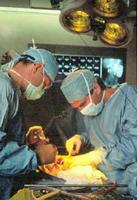 Educators in all specialties of medicine are increasingly studying Web 2.0 technologies to maximize postgraduate medical education.
Educators in all specialties of medicine are increasingly studying Web 2.0 technologies to maximize postgraduate medical education.Web 2.0 technologies include:
- microblogging
- blogs
- really simple syndication (RSS) feeds
- podcasts
- wikis
- social bookmarking and networking
Although direct practice and observation in the operating room are essential, Web 2.0 technologies hold promise to innovate anesthesia education and clinical practice such that the resident learner need not be in a classroom for a didactic talk, or even in the operating room to see how an arterial line is properly placed.
Web 2.0 and advanced informatics resources will be part of physician lifelong learning and clinical practice.
References:
Anesthesia 2.0: Internet-based information resources and Web 2.0 applications in anesthesia education. Chu LF, Young C, Zamora A, Kurup V, Macario A. Curr Opin Anaesthesiol. 2010 Jan 19. [Epub ahead of print]
http://www.ncbi.nlm.nih.gov/pubmed/20090518
Image source: Wikipedia.





























